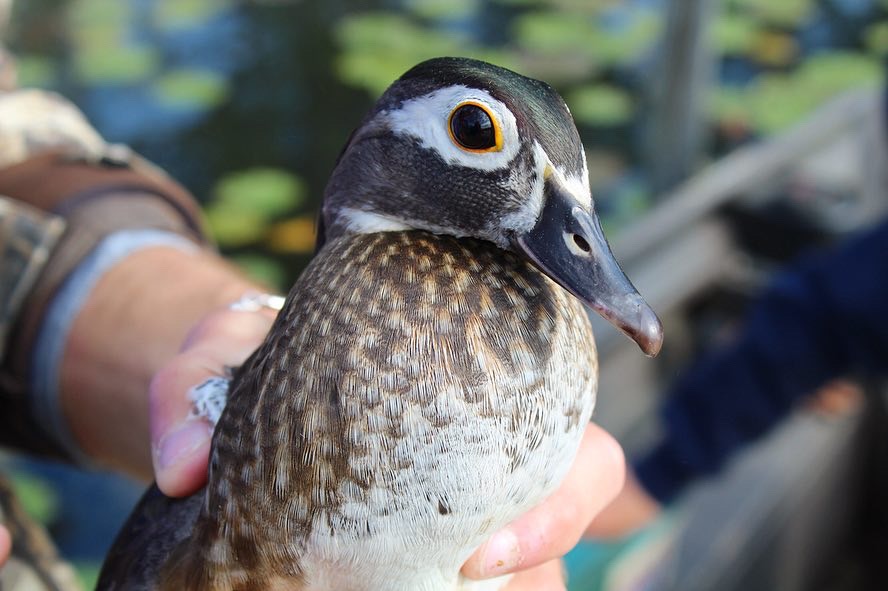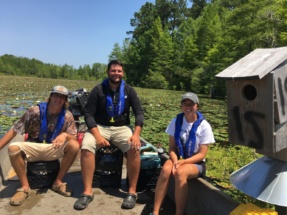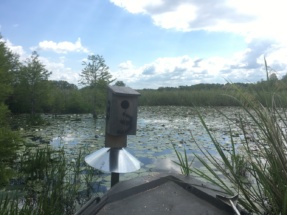



Clemson researchers collaborating on groundbreaking duck study
Clemson University researchers are studying whether a widely accepted management tool for waterfowl - nest boxes - should continue to be used.
© Clemson University
A nest box, which is simply an artificial enclosure in which birds nest, are built for wood ducks and other species of waterfowl are often fitted with metal guards around their support posts to ward off snakes and other climbing predators.
In 2018, Nemours Wildlife Foundation, in Beaufort County, S.C., gathered more than 30 waterfowl biologists from across the Southeast to address and develop research questions regarding habitat and population research and management for waterfowl using the South Atlantic Flyway. These experts decided it was time to evaluate the effectiveness of nest boxes as a conservation strategy.
“All the states and their departments of natural resources and other conservation partners have lots of nest boxes out there — hundreds of thousands of them — and what should we do? Should we continue this management strategy? Or are these boxes what we might refer to as ecological traps,” said Clemson Professor Rick Kaminski. “We erect them, we attract hens, they produce ducklings that leave the boxes, but the ducklings may get eaten by a myriad of different predators. Are these box-nesting populations sustaining themselves? That’s the question we’re trying to address.”
Now, a regional Mississippi and Atlantic Flyway Study of Box-Nesting Wood Duck Recruitment among federal, state and private entities in eight US states — both Carolinas, Maryland, Delaware, Georgia, Florida, Mississippi, Louisiana and Wisconsin — seeks for the first time to collect data at a regional scale to determine if nest box programs are effective.
That is, to determine whether the rate at which nesting hens and their daughters return to nest and produce offspring is adequate to sustain or grow the population, or are the boxes “sinks,” causing these populations actually to decline without immigration of females from other areas.

© Clemson University
The Nemours Wildlife Foundation, South Carolina Department of Natural Resources (SCDNR), Clemson University’s James C. Kennedy Waterfowl & Wetlands Conservation Center, and Clemson graduate students Emily Miller and Jacob Shurba completed a pilot study for the project in 2019 on Lake Moultrie, near Bonneau, S.C., banding and tagging ducklings and hens and are now tracking recruitment rates of ducks using 169 boxes in this study area. The study will continue for three to five years at Lake Moultrie and in the aforementioned states. More than 1,000 boxes will continue to be monitored across the nine states.
Ernie Wiggers, director of the Nemours Wildlife Foundation, said there is a reason this type of study has not previously been done widely: because it requires a regional approach and years of data collection.
“This is where we feel our involvement and support can be important as we are very willing to join in this effort for as long as it takes to tackle this question,” Wiggers said. “This is a research priority developed with the input from waterfowl biologists across multiple states, so we feel this research addresses very relevant questions. Having smart, energetic graduate students involved is a bonus. They’ll develop great data sets, analyze these data and provide the results while gaining incredible experiences they’ll use to become our future professional biologists. It’s wonderful to be able to join with other organizations like the Kennedy Center, Clemson University, state and federal agencies to attack this research question.”
In the early 1980s, SCDNR began a highly successful statewide wood duck box program. Through this program SCDNR and partners construct and distribute nest boxes and predator shields to private landowners. Since the beginning of the program, an average of 1,300 units have been distributed annually and demand for nest boxes seems to increase every year.
SCDNR waterfowl biologist Molly Kneece, a Clemson alumna, said a contemporary nest box study is long overdue to examine the true contribution that artificial structures have on wood duck populations across the southeast.

© Clemson University
“SCDNR is excited to partner with Clemson and the Nemours Wildlife Foundation to accomplish this goal,” Kneece said. “SCDNR helped play an early role in the development of this research and selecting study sites. The agency continues to ensure students have the tools they need to complete their work in the field; from housing and boats, to new nest boxes and predator shields, and ensuring the proper federal bird banding permits are in place. We are excited to see the end results from this study and apply that knowledge to improve our management of wood duck populations in South Carolina.”
Wood ducks are known as “cavity nesters,” meaning they nest in natural cavities in forested environments to avoid predators. In the early 1900s, bird populations were being extirpated primarily because of a loss of habitat and, in the case of ducks, because they were widely hunted for the market.
“When the forests started to be harvested, the cavities that occurred naturally in these trees, decreased significantly, and people got the wise idea to begin using nest boxes,” Kaminski said.
In turn, researchers began studying the effectiveness of wood duck boxes, and studies by Frank Bellrose, who became known as “the father of wood duck ecology,” and colleagues found the ducks accepted the boxes and experienced high nesting success.
Thus, hundreds of thousands of these boxes have been erected across North America over the last century, and numerous studies have been conducted on their use by wood ducks and other nesting species. Only one such study, however, has analyzed recruitment from these boxes.
This study was conducted in South Carolina by Clemson alumnus Gary Hepp, and his and colleagues’ 14 years of data collected at the Savannah River Ecology Lab near Aiken suggested that population was not sustaining itself.
“Other hens or daughters of other hens must immigrate to the site and use boxes,” Kaminski said. “These hens can be from other boxes elsewhere or other cavities, but the bottom line is without that immigration of additional birds, that population is declining.”
In the new study, the research teams across the states fit hens and ducklings with bands and web tags, respectively, to mark individuals uniquely and determine how many return to rejoin the same breeding population from which they were hatched. The project also seeks to answer why wood ducks choose the boxes that they do, as various studies have debated the reasons.
Beyond those questions, of course, the study aims to specifically determine what programs such as the nest box program are contributing, if anything. It is estimated there are over 35,000 wood duck boxes in the Atlantic flyway itself, but recruitment data from those programs are lacking. The sustainability of wood duck populations is also being studied, whether or not they require immigrants to keep the population going.
“Wood ducks are one of the most heavily harvested ducks in the eastern portion of the United States … so they hold a really high economic potential in this portion of the country,” Shurba said. “Because of people buying things like duck stamps to be able to hunt and also ammo, weapons, firearms — portions of all these sales go to waterfowl and wetlands conservation. So, the more hunters there are, the more money that is going to state and federal agencies specifically for managing wildlife and their habitats.”
Wood ducks comprise about 10 percent of the annual duck harvest in the United States. Wood ducks are second, only to mallards, in total harvest in the Atlantic and Mississippi flyways in 25 of the past 30 years.
South Carolina has one of the most ambitious nest box programs in the U.S. and, because there are resident wood duck populations in the state that do not migrate, the state provides ideal wetlands for hunters, waterfowl watchers, and researchers. “You can get the full scope of the birds’ life cycle in this state,” Miller said.
In addition to continuing the research at Lake Moultrie, along with a similar pilot study that took place in Delaware last year, the multi-state and year collaborative research project has expanded its research base to include sites in the other states participating in the effort.
The data collected, in turn, is expected to fill the knowledge gaps needed to determine, for the first time, whether wood duck nest box programs are sustainable or whether they are — so to speak — for the birds.









